Comment on SLASH 2024 is on its way! by Katie
Why don’t you have pine needles under the accepted column. Seems logical to me that it’s accepted but some very literal people might not understand it’s accepted if it’s not on the list.
Why don’t you have pine needles under the accepted column. Seems logical to me that it’s accepted but some very literal people might not understand it’s accepted if it’s not on the list.
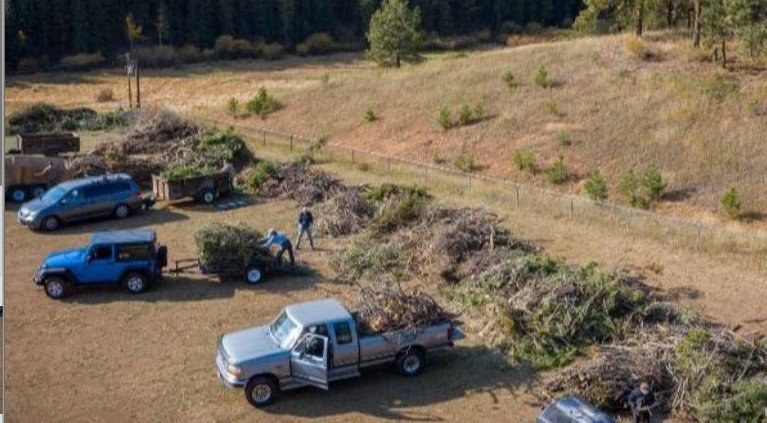
SLASH – Sustainable Lands And Safer Homes — is back for 2024! The anticipated start date for the opening of the first SLASH site is May 23rd, and the program is scheduled to continue through the end of October. At the time of this writing, the location schedule has not been published, but we will advise when it’s available.
Any size truck or trailer is welcome at Jefferson County Slash Collection sites. Dump fees are based on six cubic yards (162 cubic feet) of material: six yards is one load. The cost to drop off a single load is $24. Credit cards only. This is equivalent to:
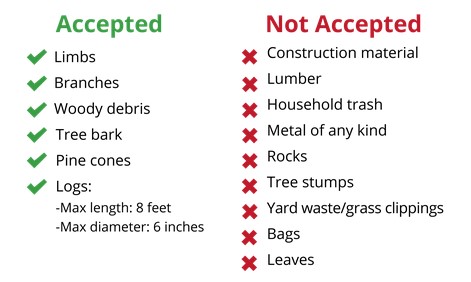
For additional clarification on what’s accepted and what’s not, or how to better calculate costs, go to https://www.jeffco.us/2493/Slash-Collection
For more information and to stay up-to-date, sign up for Alerts. It’s free, non-intrusive, and you’ll be notified of schedule changes, closures of SLASH sites, and updates to the SLASH program. Enter your email address at the top of the page, scroll down to the Alert Center section, look for Jeffco SLASH and choose the email or cell phone icon — or both — to receive alerts.

Miss Mountain Manners wants to thank everyone who will take part in the 2024 SLASH program. Removing slash and creating a defensible space around your home is the first line of defense against wildfires, which are a consistent cause for concern in Jefferson County. You can create zones around your home, removing any fire fuels, such as tree debris, to create a properly mitigated property. This doesn’t mean that wildfire will pass you by, but it gives the fire department a better opportunity to save your home when it does happen. Great tips on how to protect your home and property can be found on the Jeffco Sheriff’s hazard mitigation page and at FireWise website. Jeffco’s CSU Extension also has a factsheet that can help homeowners plant low-flammability gardens.
The post SLASH 2024 is on its way! appeared first on PLANJeffco.
Editor’s note: This is a reprint of the original article published by Ann Bonnell, June 1st, 2011. Rest in peace, Ann, we will never forget you or the expertise in bird life that you were so fond of sharing.
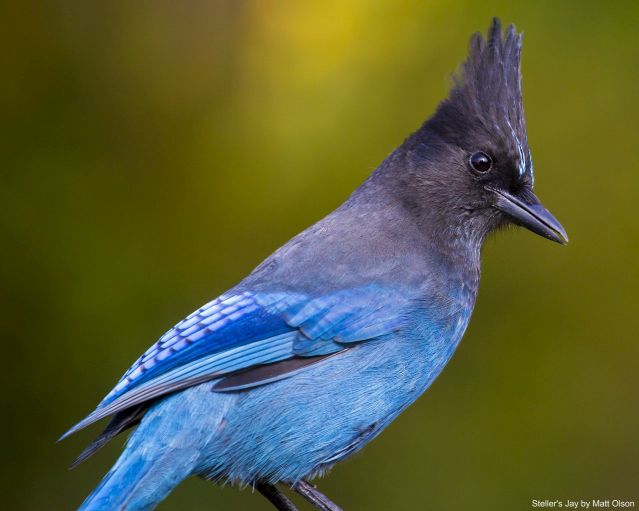
— Steller’s Jay, photo by Matthew Olson
The Corvids are probably the most notable family of birds with an attitude. They are loud, pushy and act like they are the boss, running off other bird species and often eating other birds’ eggs and hatchlings. The Corvids found in our area include Common Raven, American Crow, Western Scrub-Jay, Pinyon Jay, Blue Jay, Steller’s Jay, Gray Jay, Clark’s Nutcracker and Black-billed Magpie.
Each species has a special habitat or niche. All Corvids have stiff, bristle-like feathers covering their nostrils. They are omnivorous; they’ll eat most anything. In addition to the bad habits they often get blamed for, they do a good job of eating large quantities of harmful insects. They also harvest and store tree seeds, which they sometimes forget about, and the seeds then grow into new forests. Bird watchers thank them for finding owls and hawks which they noisily mob, giving away the raptor’s hard-to-see perch. Corvids often mate for life, each assisting with nest building, and feeding hatchlings and fledglings. Often young birds from a previous hatch will help with feeding the young of a later hatch. Many Corvids live more than 20 years. Some stay on home territories and some migrate in family groups or large flocks, either to lower elevations or by short migrations to warmer climates for the winter. They often become quiet and secretive when nesting. The “bad” in their behavior earned them places in the folklore of many cultures. In Europe they were considered “Devil’s birds.” Some cultures, such as those in the Pacific Northwest, revere them. Corvids are considered to be among the most intelligent of all bird groups. Many will recall with unerring accuracy where they have stashed food for the winter. Flocks of Corvids have been known to post one of their own to watch for danger while the others eat, sleep or loaf. David Sibley informs us that recent DNA-hybridization studies suggest that Corvids arose from an Australian ancestor. The same ancestor also gave rise to many distinctive Australian bird families, including wren-like, warbler-like, and flycatcher-like groups. North American shrikes and vireos are thought to be offshoots of the same line. Many Corvids contracted the West Nile virus when it first appeared in the U.S. in 1999, decimating populations. In the last few years population numbers have begun to recover.
Steller’s Jay is usually found in Colorado between 6,000 and 9,000 feet elevation. They are named after George Steller, a German naturalist who accompanied Vitus Bering on his Russian-sponsored expedition to see if the coasts of Siberia and Alaska were contiguous. George Steller collected the first Stellar’s jay specimen in 1741. Steller’s Jays are excellent mimics. Multiple times I have been fooled into thinking a Red-tailed Hawk was present and calling, when in fact it turned out to be a Steller’s jay. They can also do a reasonably good job of mimicking the sound of a rattlesnake. They were formerly known as Longcrested jays because of the long crest of black feathers on the head. The Steller’s jay nests are hard to find and they are often incubating eggs by early May. Lt. Abert on Fremont’s third expedition described this jay well in 1845 when he wrote “a jay whose plumage partook of the color of the darkest blue of a clear sky.”
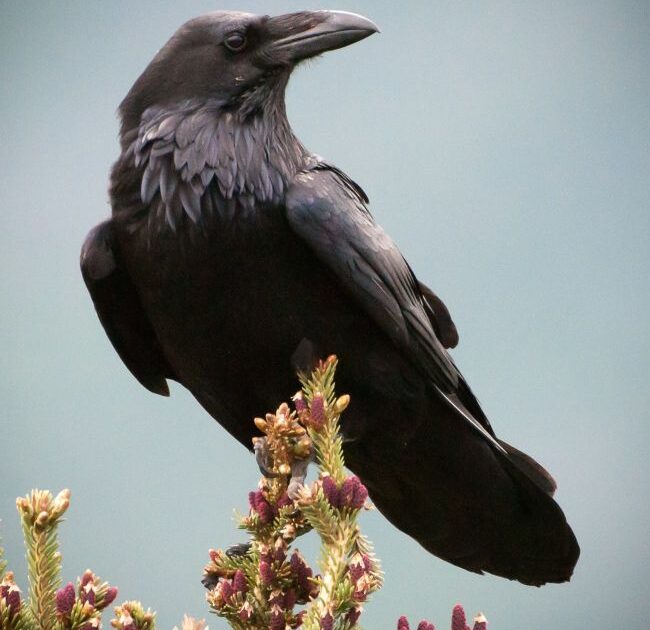
Common Raven, photo by Kent Miller
Common Ravens are probably the most famous of the Corvids. They soar in elaborate, twirling displays during courtship. They prefer rocky ledges as hangouts and for nesting. Ravens never retrieve sticks from the ground for their nests, preferring to break dead branches from trees for nest building. Ravens, like owls and raptors, regurgitate pellets of indigestible parts of things they eat. When trying to differentiate them from American Crows, it helps to look for the raven’s wedge-shaped tail, to listen for the raven’s hoarse, croak call, and to watch for mostly soaring flight, with very little wing-flap. They have a larger bill than crows. In folklore, the raven flew off from Noah’s ark to find land. A story in the Bible tells of ravens bringing food to a prophet who was starving in the wilderness. Old Testament laws forbid eating ravens and crows because they were considered unclean. They are depicted on many totem poles of the Inuit, Tlingit and Haida cultures. In merrye olde England, it was believed that if the resident ravens left the Tower of London, King Charles II’s kingdom would fall. Since that time, the ravens are fed and cared for by a Ravenmaster to prevent any such disaster from occurring. The Ravenmaster clips a few flight feathers from one wing of each bird regularly to keep the birds from flying away. When these particular ravens die, they are buried in a special grave by the Middle Drawbridge, and each has a plaque with its name and age at death. One of the most famous Colorado ravens belonged to Catherine “Birdie” Hurlbutt. Catherine took in hundreds of injured and sick birds and nursed them back to health, rescuing them in a very old car painted white with “Bird Ambulance” printed on the side. In 1971 she decided to do some research on teaching birds to talk. She mail ordered a young raven from another state (a practice outlawed the next year). She spent many hours teaching “Edgar” the raven to say “nevermore.” In Edgar’s first few years he learned to say, “Nevermore, Hi-ya, Edgar, you’re a bad boy and hello.” Catherine called Edgar a he in most of her book, Edgar and I. In the later years of writing the book she discovered Edgar was a she because of certain courtship behaviors Edgar displayed. Edgar lived for 24 years. Catherine’s book is a fun read relating her stories of Edgar in addition to other bird rescue tales.
Editor’s note: “Edgar and I” by Catherine Hurlbutt is available at Amazon.
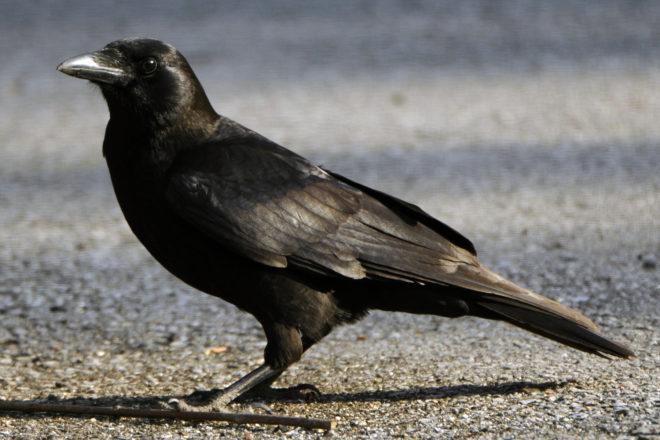
Crow on driveway, photographer unknown
American Crows are usually found in open and semi-open habitats. They have straight, square-ended tails and a clearer, higher-pitched call than a raven. They are smaller than ravens and flap their wings a lot when flying. Opening up roads and creating forest clearings has helped them move into new areas. During the winter, crows often gather in large flocks, flying in one day from roost to eating areas, then on to loafing areas, then to another eating area and at the end of the day back to the communal roost. Crows love to hoard bright objects. They also regurgitate pellets of indigestible material. The Tillamook Native Americans have a story about the Thunderbird (who was responsible for making thunder and lightning) not liking its voice and working a deal to trade its voice with the crow. In exchange, the Thunderbird would make lower tides along the coast so the women of the Tillamook clan could gather more clams. We have many sayings about crows: “Eat crow” when one finds it necessary to retract a deed or quote. “Straight as the crow flies “illustrates the crow’s habit of flying in a straight line to their roost. Age puts “crow’s feet” wrinkles around the eyes. During courtship the male spreads his wings and tail, fluffs body feathers and bows several times to the female while singing a rattling song. Many crows have been poisoned, shot and even dynamited when they gather in large flocks of thousands to eat farmers’ crops.
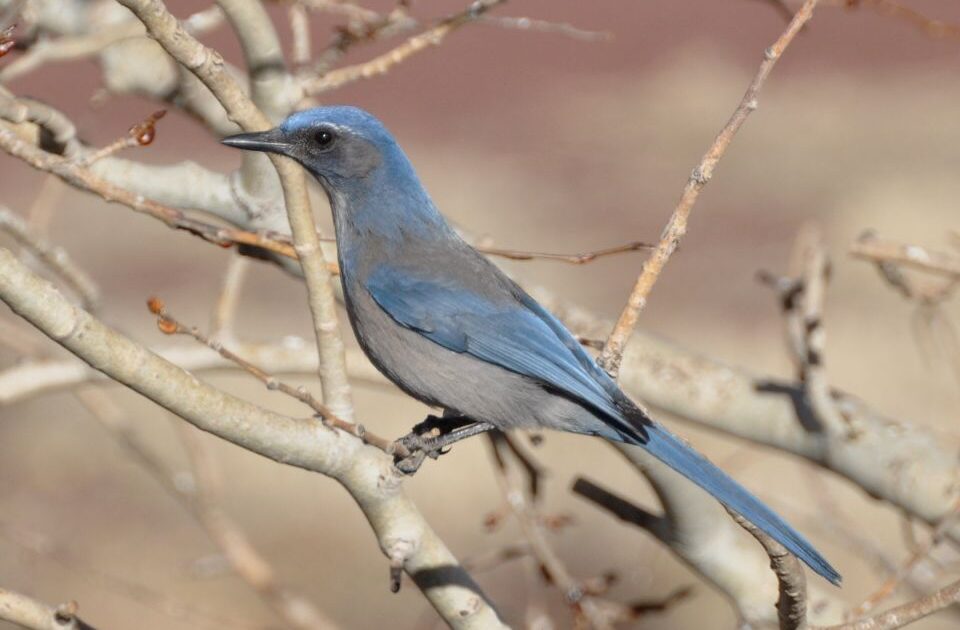
Western Scrub Jay, photo by Pam Koch
Western Scrub Jays are found along the Front Range in the Transition Zone from the plains to the mountains. They hang out in scrub (Gambel) oak. They are usually found in small family groups and stash the oak acorns for food so they can have them later. They will come to a bird feeder, run off all the little birds, and proceed to pick up as many as 20 sunflower seeds in one visit, which they will then stash in their hide outs in the ground, in cracks and bark crevices, even in snow banks. They may migrate short distances south, especially in years when the acorn crop is poor. They have no crest and look grayish until the sun touches their feathers. They were once called Woodhouse’s Jay. They will also hoard bright objects.
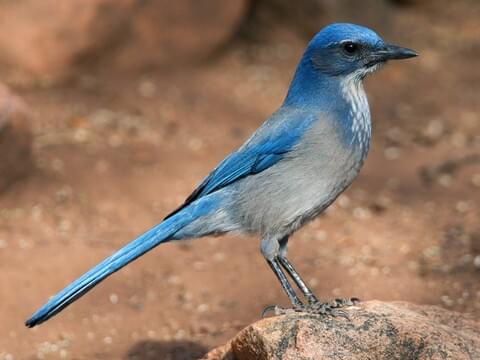
Pinon Jay, photo from Cornell Lab of Ornithology
Pinyon Jays are sometimes found in small flocks in our area. Like the Western Scrub jay, the Pinyon jay has no crest, however, they are bluer than Scrub jays, especially on the breast. Their calls are very different than the calls of Western Scrub jays. Pinyon jays prefer Pinyon pine/juniper habitat but sometimes show up along the lower foothills in Ponderosa pine areas. They often walk instead of hop as other jays do. Crows and Clark’s nutcrackers also walk. Genetically Pinyon jays fit intermediately between jays and crows. They are one jay that does not have bristles covering their nostrils giving them their scientific name Gymnorhinus which means naked nose. They were discovered by Alexander Philip Maximilian, Prince of Wied, noted German traveler who first found them in Montana in 1883. They breed in colonies. Breeding is triggered by availability of Pinyon nuts which they cache for food in late winter, often when snow is still on the ground. If you find seedling trees uphill from a parent tree, most likely a Pinyon jay cached and forgot. Pinyon nuts cached by squirrels and birds and then forgotten can sprout and grow.

Blue Jay, photo from Cornell Lab of Ornithology
Blue Jays have crests. They were originally found in states east of Colorado, however, when we created their favorite habitat by planting Eastern region trees and shrubs, they gradually moved up river courses to Denver (the first record in Jefferson County: September 24, 1917). They love to stash seeds from bird feeders. I have watched one in my backyard poke holes in the sod and place the seed in the hole, and then put a leaf over the hole to hide the stash. I then noticed a squirrel who had figured out the ruse, looking under leaves on the ground for gifts left there by the blue jay. Blue jays usually don’t migrate south in winter except for the extreme northern bird populations. They will announce the arrival of a fox, cat, owl or other raptor by loud calls as they mob the intruder. In addition to this loud raucous call they have a quieter flute-like call. In Colorado the blue jay has been known to hybridize with Steller’s jays.
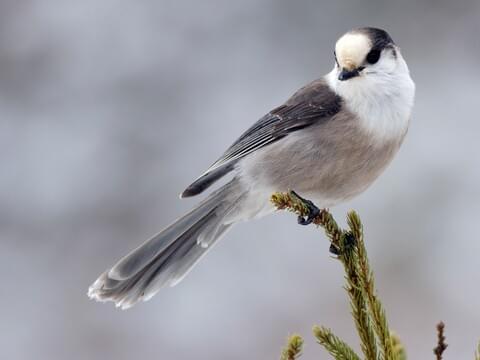
Gray Jay, photo from Cornell Lab of Ornithology
Gray Jay has also been called Rocky Mountain Jay, Canada jay, Jackdaw and Camp Robber. Another name “Whiskey Jack,” is believed to have come from their Cree name of “Wisca Chan.” They are the only Old World jay present in the New World. They have a large round head and small bill. They are very tame and will snatch up food left unattended. They are also known to carry off such items as matches, tobacco plugs, pencils, soap and candles. They can store food in a sticky bolus mixed with saliva and placed on a limb or tucked under tree bark for use in lean times. Some jays have been known to remember as many as 1,000 separate caches. [Is this the gray jay, or jays in general?] Gray Jays are mostly silent and are usually found in pairs or small groups. Their habitat is the Montane Zone and Boreal Forest of Engleman spruce, Douglas fir and Lodgepole pine. Any migration is usually to a lower elevation in winter. They usually start nesting in late March while snow is deep; the eggs hatch in early April.
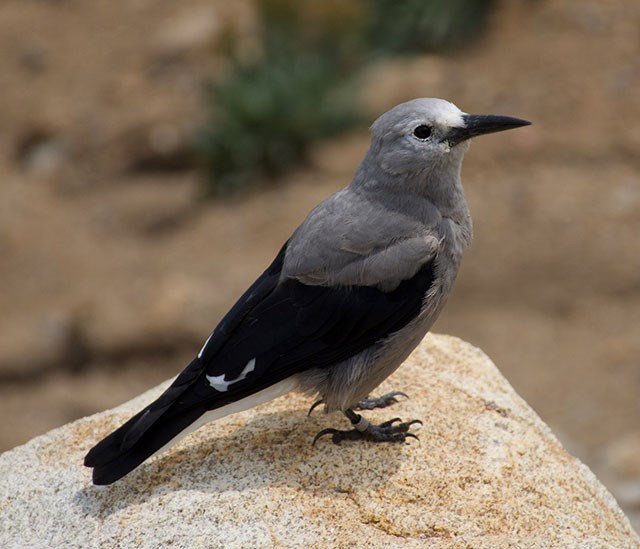
Clark’s Nutcracker in Rocky Mtn National Park, photo from National Park Service
Clark’s Nutcracker, which was once known as Clark’s Crow or the Woodpecker Crow, is named after Captain William Clark of the Lewis and Clark Expedition. The Clark’s Nutcracker is like a combination of a woodpecker and a crow. It has a long, stout bill which it uses to open pine cones and eat the seeds. It often walks instead of hopping. They are found near timberline along crests of higher mountains, usually in small groups. They can do a good mimic of the calls of the Great Horned Owl and the Pygmy Owl. Their nests are seldom found because they nest during March and April when there is still deep snow on the ground. Female birds loose feathers on their breasts during incubation to enable them to keep the eggs warmer. Clark’s Nutcracker males are unusual in that they also develop these “brood patches.” Research has shown males incubate the eggs as much as 20% of the time. They have been known to collect as many at 30 – 100 seeds at once in a sub-lingual pouch to stash for use in the spring to feed new hatchlings. These caches on south-facing slopes have been known to contain 22,000 to 33,000 conifer seeds.
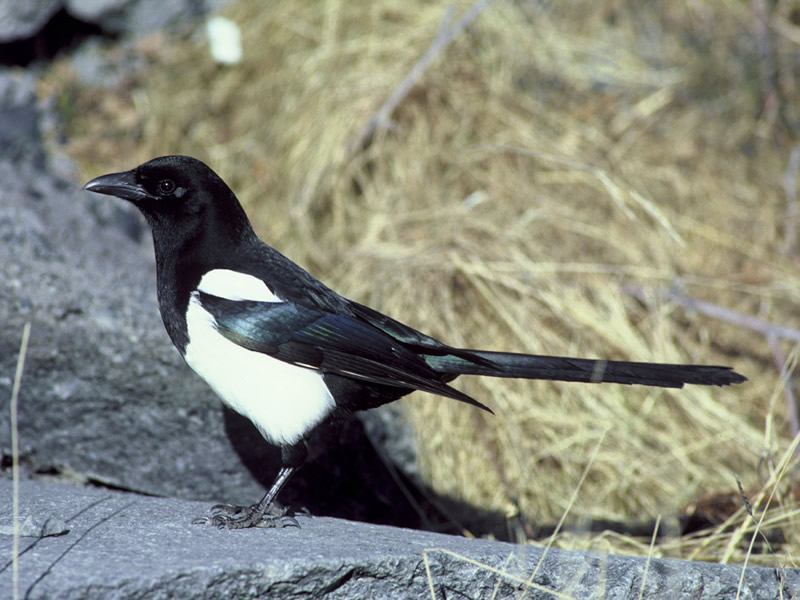
Black-billed Magpie, photo from National Park Service
Black-billed Magpie is a common bird in Colorado open country [and in the foothills, too—at least judging by the numbers that hang around Lookout Mountain!]. Colorado often gets the highest count of Magpies on the annual National Audubon Christmas Count totals by state. Magpies are very noisy birds and they love to steal dog food left outside. Their nests are elaborate, hollowed-out piles of sticks, lined with mud and soft materials , usually containing several entrances. They may spend 40-50 days building a nest. Sometimes, after the Magpies finish nesting, the dome collapses and hawks or owls will take over the location. Magpie eggs are often lain by the third week of April. They usually travel in small, family flocks occasionally increasing to larger flocks in winter. They will perch on livestock, elk, deer and eat ticks or other parasites. The name Magpie may come from the sound of their call. Legend has it that the Magpie was the only bird that refused to enter the Ark, preferring to perch on its roof, from which it could complain about the plights of those caught in the rising flood. Their numbers are increasing after declining dramatically following the onset of the West Nile Virus.
Copyright © 2011 Ann Bonnell
The post The Bird Family with an Attitude: The Corvids appeared first on PLANJeffco.
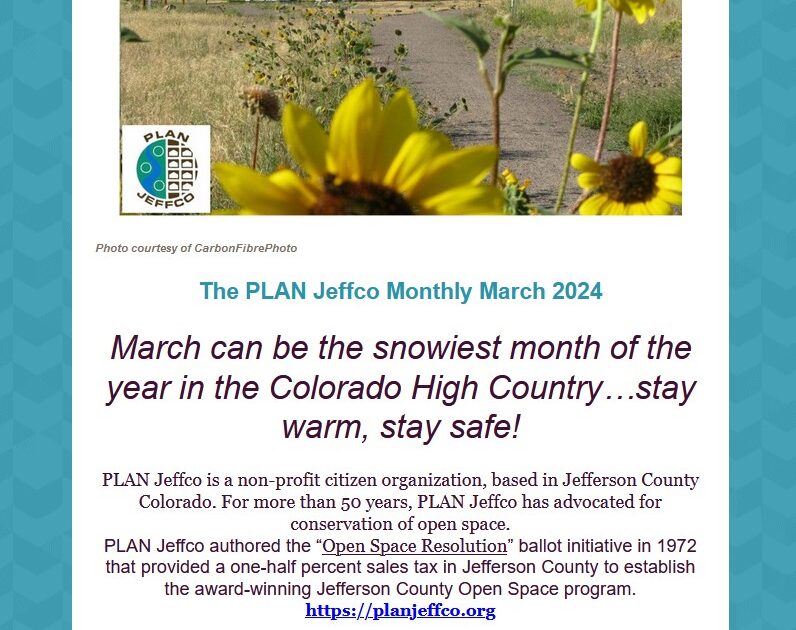
Download your copy of the March 2024 PLAN Jeffco Monthly newsletter here
The post The PLAN Jeffco Monthly – March 2024 appeared first on PLANJeffco.
[…] Snowbirds https://planjeffco.org/snowbirds/ […]
[…] Snowbirds https://planjeffco.org/snowbirds/ […]
[…] The Bird Family with an Attitude: The Corvids https://planjeffco.org/the-bird-family-with-an-attitude-the-corvids/ […]
[…] Birds of Jefferson County: Accipiters https://planjeffco.org/birds-of-jefferson-county-accipiters/ […]
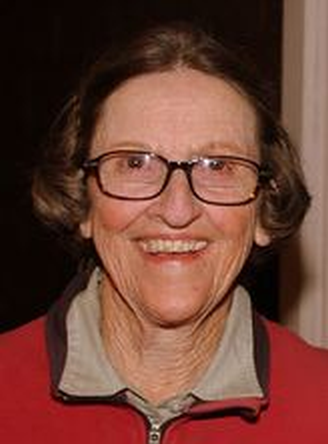
Ann Bonnell’s death on December 26th, 2023, at the age of 85, left a gaping hole in the heart of the Jefferson County birding community and in the hearts of her fellow PLAN Jeffco Board members.
Ann’s life was focused on family and service. As a high school biology teacher and volunteer Water Safety Instructor for those with special needs, she was able to reach into the lives of many, passing along her belief in service, empathy, and passion for the outdoors and all that it encompasses. Her specific focus, as we at PLAN Jeffco knew her, was birds – birding, leading Tuesday Birders, and teaching about bird life.
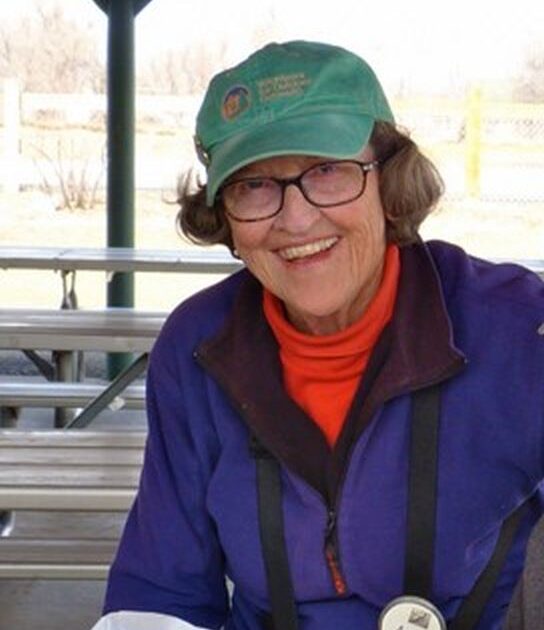
Ann Bonnell leading Tuesday Birders, photo courtesy of Family
Another passion of Ann’s was water and water quality. While on the Board of PLAN Jeffco, Ann monitored the reengineering at Chatfield State Park and reservoir, keeping us updated on the process and progress of that years-long operation. Shortly after joining PLAN Jeffco in 1997, she became deeply involved with the Save the Mountain Backdrop project here in our own Front Range, helping focus conservation efforts on the many watersheds that make up the western portion of Jefferson County.
Ann was an inveterate volunteer. She gave of her time and energy to volunteering with special needs populations and coaching Special Olympics swimming and cross-country skiing, which gave her a specialty in accessibility issues for our Open Space Parks. She was a Volunteer Naturalist for Roxborough State Park, South Platte Park, Denver Botanic Gardens and the Audubon Society of Greater Denver.
Ann wasn’t just a Board member of the Audubon Society of Greater Denver, she was their 2nd Vice President. She served on their Conservation, Trip, & Nature Center Committees, which gave her a very good reason to guide nature tours and kayaking trips at every opportunity. As a technical specialist for Audubon, she served on the Restoration Advisory Board for the Air Force PJKS Superfund site, located at their former Waterton facility. She truly was a force of nature.
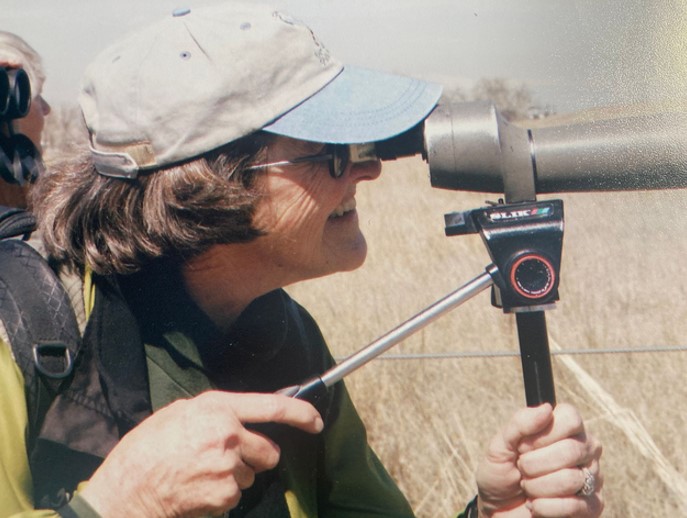
Ann Bonnell, Tuesday Birders, photo courtesy of Family
Ann believed in our mission: “PLAN Jeffco works to preserve open space in a manner consistent with our core conservation values by educating and monitoring government agencies, advocating, and working with aligned associations and citizens.”
She realized that, by working to conserve nature and open spaces, adding much valuable information on bird and birdlife requirements, she could be instrumental in providing safe habitat for her beloved birds.
One of the greatest gifts that Ann gave to us and to the world was her daughter, Mary Ann Bonnell, who is known as Jeffco Open Space Ranger One. The photo of Ann and Mary Ann on the PLAN Jeffco About Us – Board Members page is emblematic of the wonderful relationship between these two leaders in our conservation community. Mary Ann will most surely continue to champion her Mom’s belief in the value of nature, while teaching humans how to respect and treasure those experiences in the outdoors.
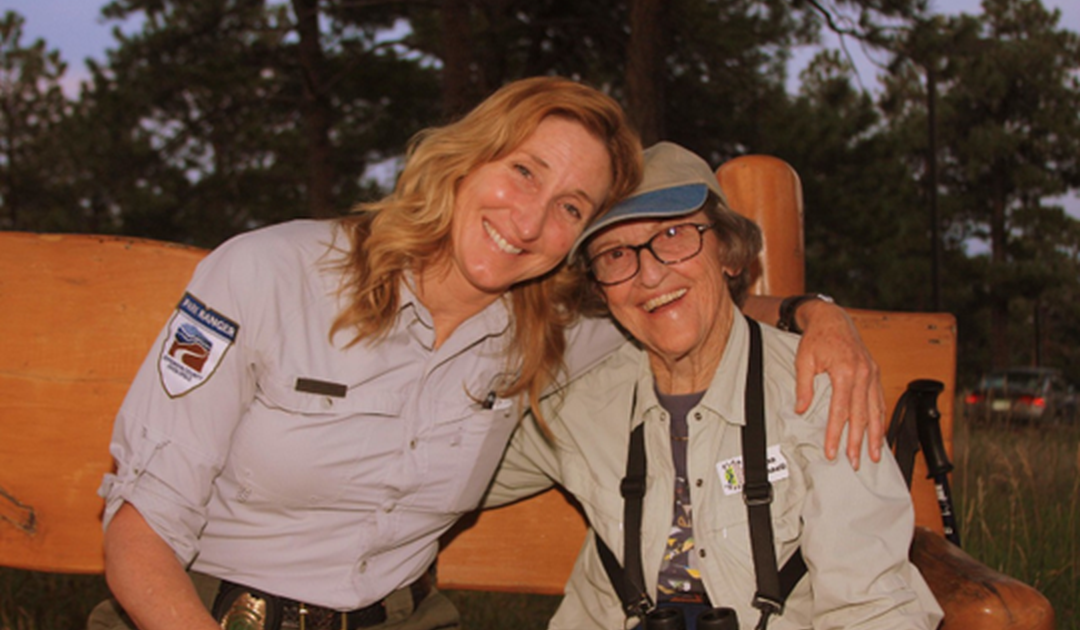
Ann & Mary Ann at the Lookout Mtn Nature Center 2018
We will miss Ann. As a committed and genuine conservationist, she kept us on the right track as we plowed our way through issue after issue. We will look to the skies, at her beloved birds as they wing their way to wherever they’re headed, and ask “What would Ann have us do?”
Articles written/co-authored by Ann Bonnell:
Birds of Jefferson County: Accipiters
https://planjeffco.org/birds-of-jefferson-county-accipiters/
Snowbirds
https://planjeffco.org/snowbirds/
The Great Backyard Bird Count between Friday, February 14 & Monday, February 17. Have You Watched Any Birds Lately?
https://planjeffco.org/the-great-backyard-bird-count-between-friday-february-14-monday-february-17-have-you-watched-any-birds-lately/
Birds of Chatfield
https://planjeffco.org/birds-of-chatfield/
The Great Backyard Bird Count (GBBC) Results Are In – from the February 2014 Count!
https://planjeffco.org/the-great-backyard-bird-count-gbbc-results-are-in-from-the-february-2014-count/
The Bird Family with an Attitude: The Corvids
https://planjeffco.org/the-bird-family-with-an-attitude-the-corvids/
A Celebration of Ann’s Life will be held at the Crown Hill Pavilion of Reflection, 7777 W. 29th Ave. Lakewood, CO, on Friday, April 5th at 2 p.m. In lieu of flowers, donations to EarthJustice, Denver Audubon, The Nature Conservancy, Bird Conservancy of the Rockies, or the Denver Field Ornithologists are appreciated.
To read more about Ann Bonnell’s accomplishments:
www.evergreenaudubon.org/saluting-ann-bonnell
Olinger Funeral, Cremation & Cemetery – Crown Hill
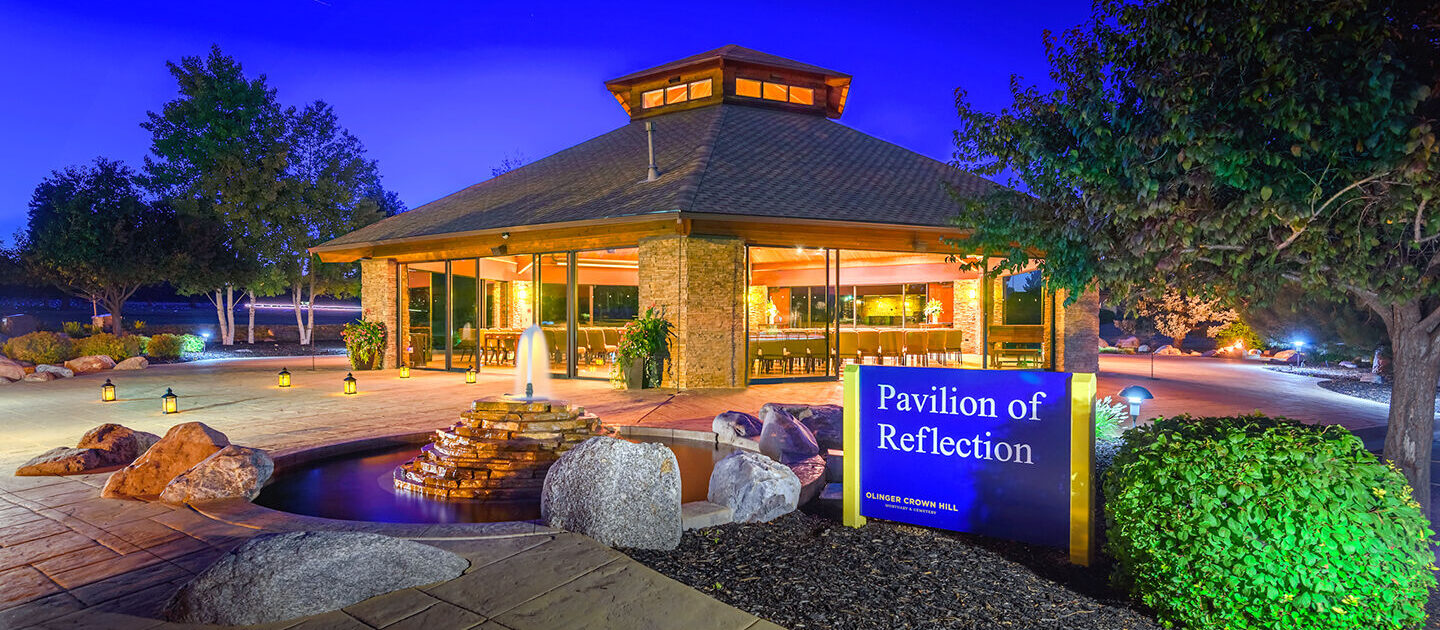
The post Ann Bonnell Lived A Life of Service appeared first on PLANJeffco.
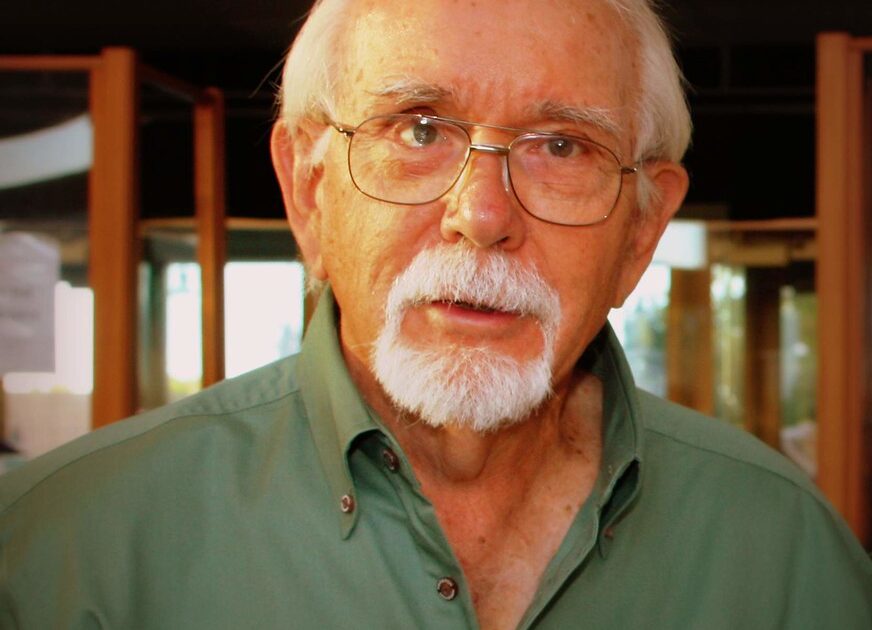
Pioneer PLAN Jeffco Board Member John Litz Served 51 years
By Vicky Gits
John Litz’s death on Dec. 29 at 87 marked the end of an epic career in the service of PLAN Jeffco and the cause of preserving natural lands in general.
A metallurgical engineer by profession, John was a remarkably prolific volunteer who donated most of his free time over the years to various charitable organizations and land stewardship causes.
He is survived by three daughters, Kari Litz, Kirstin Litz, and Denise Litz and by three grandchildren. His wife of 49 years, Karen, died in 2007.
He was a member of nonprofit PLAN Jeffco for 51 years from 1972 to 2023 and treasurer for most of that time, working closely with longtime chair Margot Zallen. He was a member of the Jefferson County Open Space Advisory Committee for 30 years, from 1993 to 2023.
John was known for his spreadsheets and mastery of finance and operations, said Ralph Schell, executive director of the open space division from 1998 to 2009. But he was also approachable. “John was just someone that everyone could appreciate and get along with.”
He was a tireless workhorse on behalf of the outdoors and a living history record of the open space saga.
At the beginning
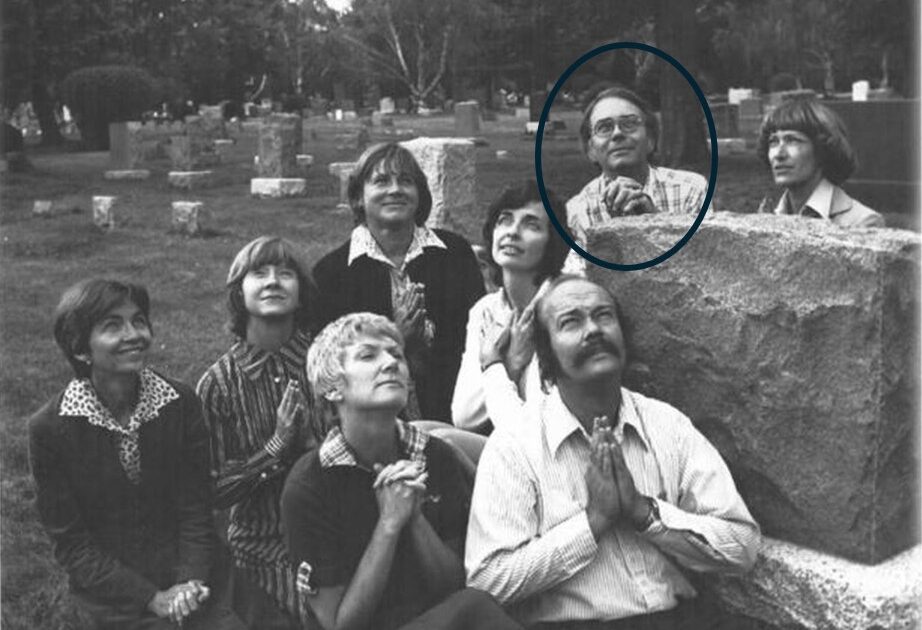
PLAN Jeffco in the cemetery 1972 (John is circled).
Litz’s involvement with PLAN Jeffco began in the fall of 1971 when it was just a grassroots advocacy group meeting in the living room of Carol Karlin in Lakewood.
At the time, raising money for raw land and putting just trails and trailheads on it was still a somewhat unusual proposition, but the citizens of Jefferson County passed the resolution with 55 percent of the vote in favor.
John Litz co-authored the 1972 measure that created the county open space agency and a half-cent sales tax to fund it. The money was for acquiring land in its natural state, parks and recreation lands, greenbelt and agricultural buffer zones, scenic easements, historic monuments, wild rivers and wildlife habitats.
John said he joined PLAN Jeffco because his wife was a member of the League of Women Voters and the league had produced an influential land-use study endorsing more parks. The league and PLAN Jeffco shared some members and PLAN Jeffco was looking for men and a Republican so they could claim bipartisanship.
One of the original PLAN Jeffco members who was the treasurer died unexpectedly and so John took over the job. He went on to ring doorbells and play a leading role in identifying and financing large parcels of land for the park portfolio.
Bargain hunting
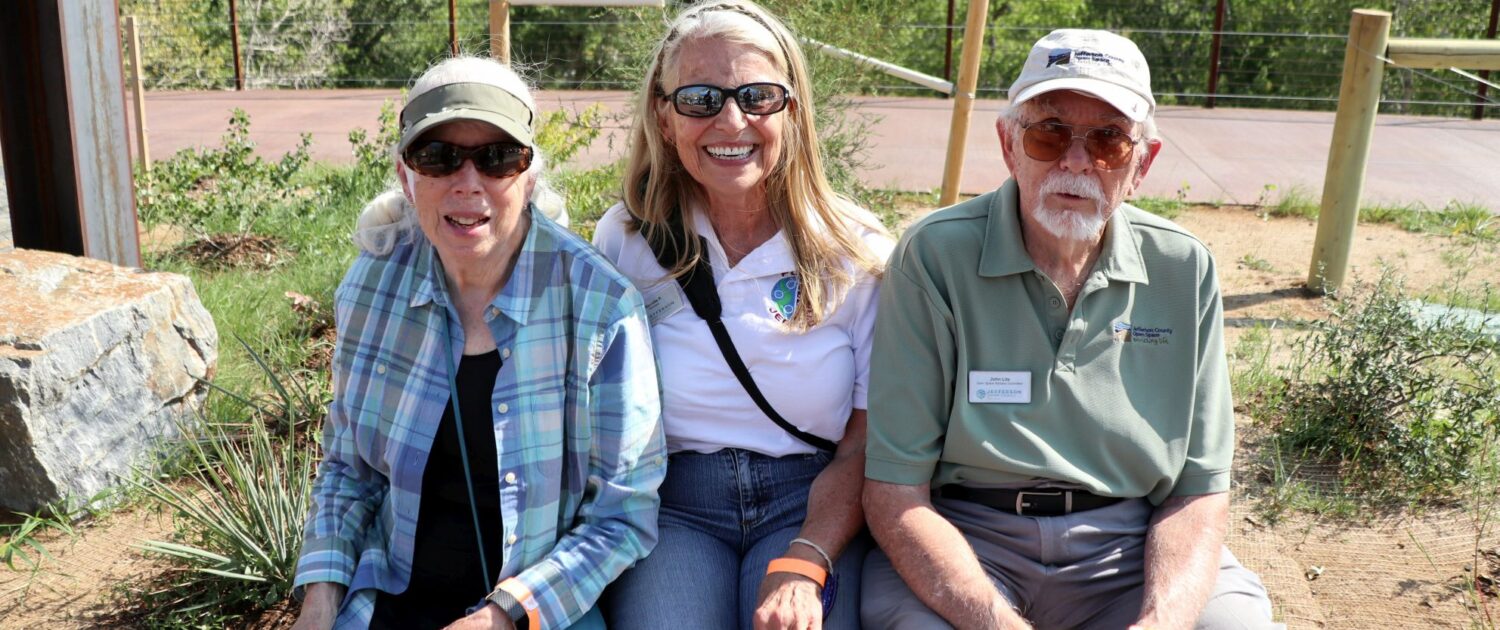
Clear Creek Gateway Tailhead Cable Cutting – Jean, Michelle & John, 2017-09-29
In the ‘90s, John envisioned raising the money to buy land before prices went sky-high. He helped organize a successful campaign to persuade voters to fund a $160 million bond issue.
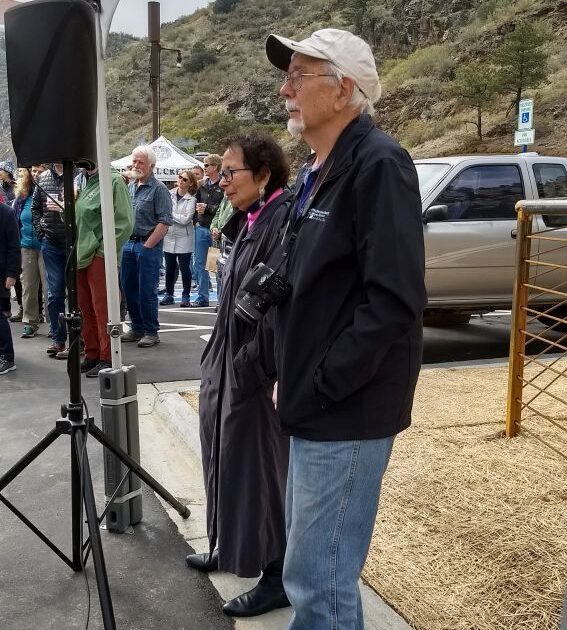
Clear Creek Gateway Trailhead Cable Cutting, John & Margot, 2017-09-29
Thanks in large part to his efforts, the park system has grown in 50 years from nothing into a Front Range empire of more than 57,000 acres of preserved land, 270 miles of trail and 27 parks, open to the public for free. The sales tax generated $61 million in 2021, according to the 2021 Preservation Progress Report.
Greg Stevinson, an OSAC member from 1989 to 2009, said John was critical in the early years to identifying and clarifying what properties needed to be acquired. “I thought of him as the silent giant. He would come in and synthesize it and explain why and from there we could take a vote and move on.”
Lasting legacies
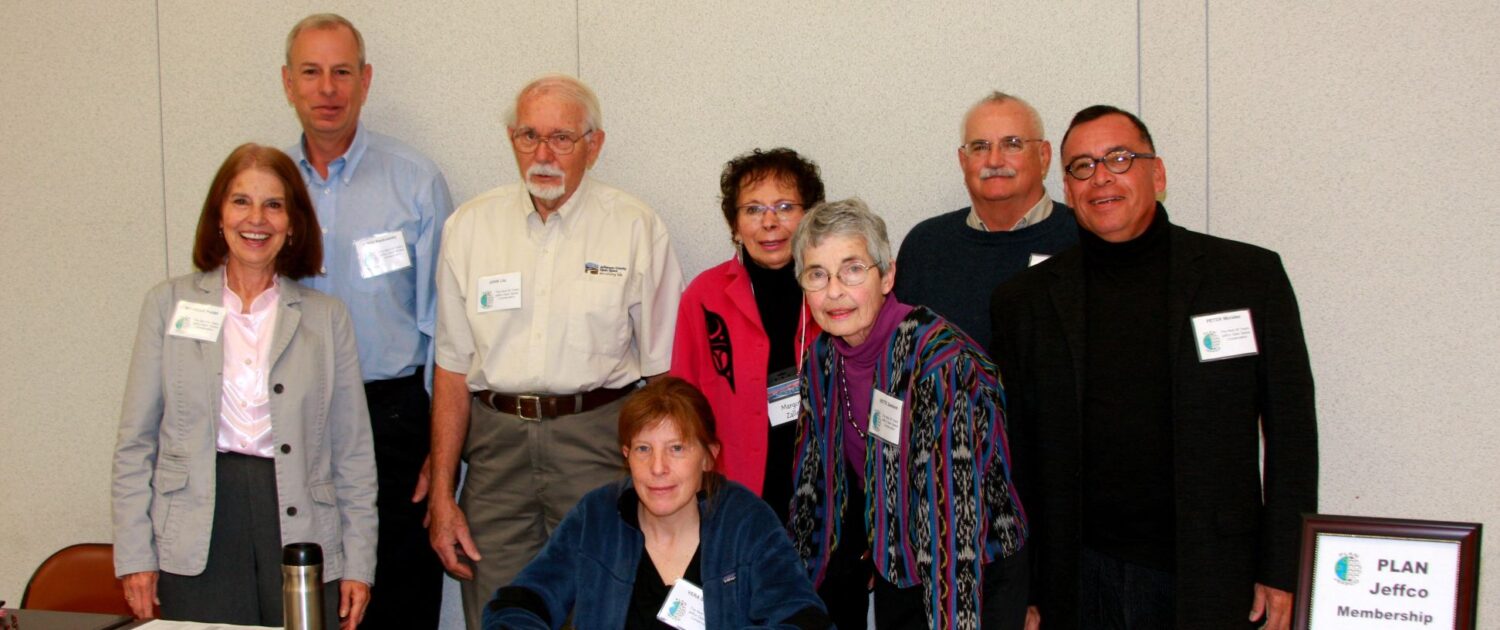
Next 40 Years Conference – the full team, 2012
Thanks to John, instead of more housing developments, residents have iconic vistas such as Elk Meadow, Alderfer Three Sisters, Evergreen Mountain, Centennial Cone, Clear Creek Canyon, South Table Mountain, Blue Mountain and the latest Douglas Mountain/Mount Tom (3,400 acres).
John was born in Zambia, Africa, where his father found work at a copper mine during the depression. The remote location spawned John’s appreciation for the value of untouched landscapes. Venturing out to collect firewood one day as a child he realized, “If we had continued north we would reach the Mediterranean without crossing an open road. Now that is open space.”
John graduated from East High School, studied at the Colorado School of Mines and earned a master’s degree from the University of Colorado. His specialty was developing processes for the recovery of metals from ores, concentrates and recyclable materials and held 16 patents. He held season tickets for the Buffalo football and Colorado Symphony.
He lived in Lakewood in a conventional subdivision, but he also maintained a cabin in the mountains near Nederland.
Maximum participation
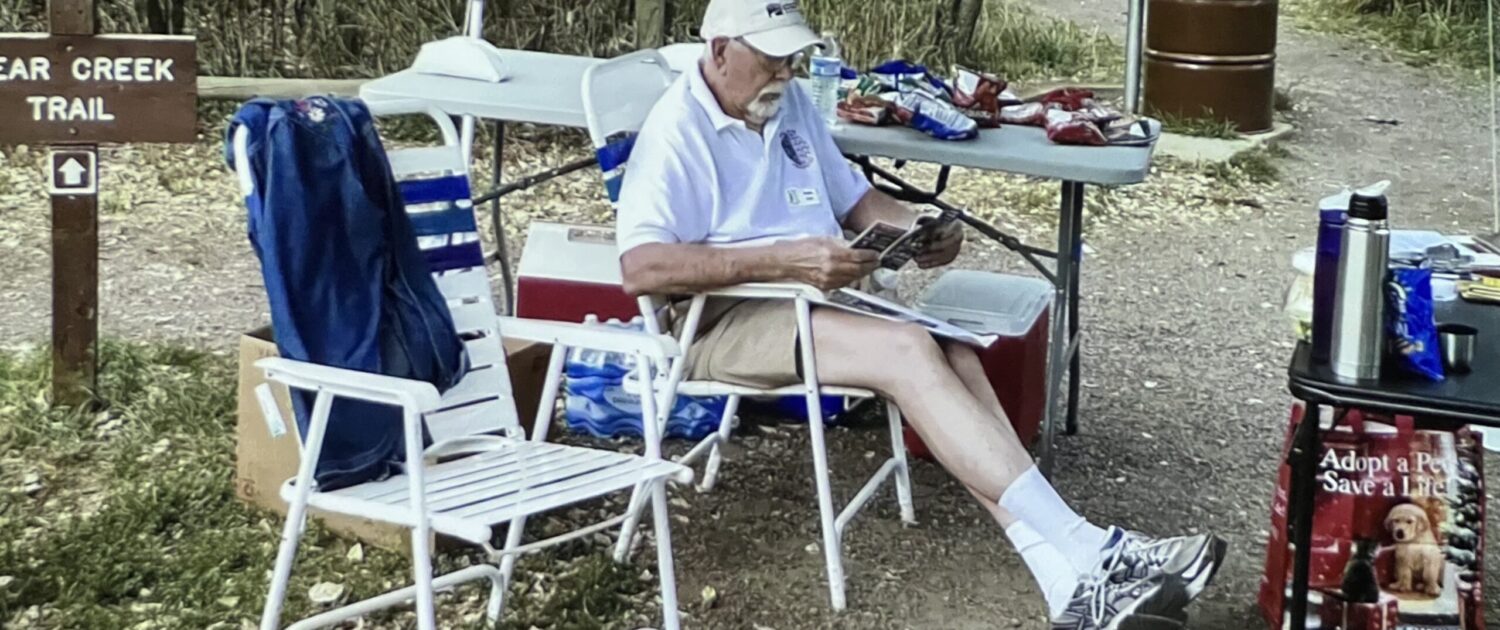
2018 InPleinSight – John at Lair O’the Bear
He attributed his dedication to community service to being brought up to participate in things, rather than be a “spectator.” He is well known for being the first to volunteer for even the most tedious and burdensome tasks and delivering the above and beyond.
In addition to his treasurer duties, John hosted Christmas parties, committee meetings and created the monthly newsletter, the Update, amply illustrated with landscape photos and nature art.
If necessary, he was willing to set up the table and tent and bring the brochures for a long day in the park representing PLAN Jeffco. He almost singlehandedly ran the sales for PLAN Jeffco’s two plein-air-painting fundraisers.
Even when he became ill, he attended fundraisers and continued to be a presence at PLAN Jeffco and Open Space Advisory Committee meetings.
John was named to the Jefferson County Hall of Fame in 2022 for preservation, volunteerism and public service. He was secretary/treasurer of the Jeffco Outdoors Foundation and helped establish a program that offers free field trips for students to the Hiwan Heritage Museum and Lookout Mountain Nature Center.
John was an officer in the Applewood Kiwanis for many years and recently became a member and secretary of the Wheat Ridge Kiwanis.
He was named a Lifetime Emeritus Member of the Open Space Advisory Committee in recognition of his “inspiration, history, wisdom and insights.”
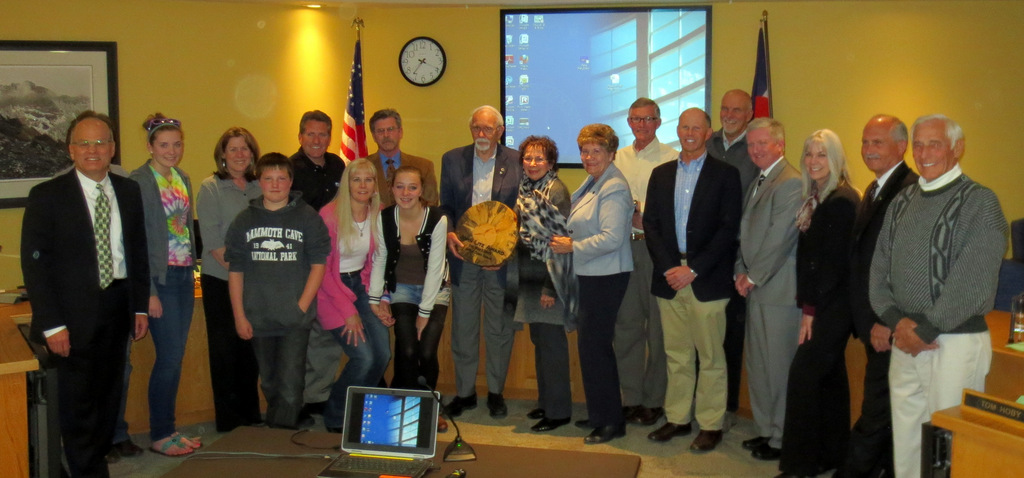
The John Litz Conservation Award, OSAC 2013
Tom Hoby, executive director of open space since 2009, said John reminds him of the quote, “The greatest thing you can spend your life on is something that outlasts it. That’s exactly what he did. … He was in his sixth decade of volunteering.”
See video memorial tribute produced by Jeffco Open Space at You Tube :
https://www.youtube.com/watch?v=8ZCCIbc4vNs
John Litz Stewardship Fund
An anonymous donor contributed $15,000 to start a John Litz Stewardship Fund and Jeffco Outdoors Foundation contributed $25,000 toward a goal of $100,000. Contributions can be made at coloradogives.org. Funds are for public lands volunteerism, visitor stewardship, courtesy, education and scholarships for conservation careers.
Other Donations
Rocky Mountain District Kiwanis Foundation, Kids Need Kiwanis, 8389 Devinney Court, Arvada, CO 80005, f24.Site.Kiwanis.org
PLAN Jeffco, 23495 Cody Park Road, Golden, CO 80401, Planjeffco.org
Jeffco Open Space Foundation, 700 Jefferson County Parkway, Ste. 100, Open Space Building, Golden, CO 80401, Jeffcoopenspacefoundation.org
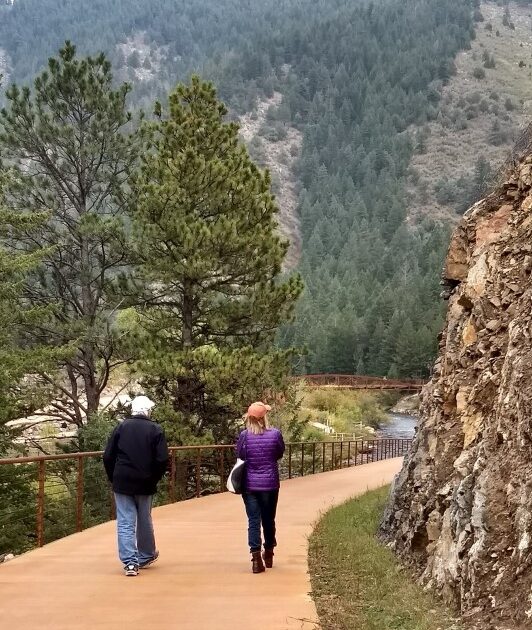
Clear Creek Trail Gateway – John walking with Vicky 2017-09-29
The post Pioneer PLAN Jeffco Board Member John Litz appeared first on PLANJeffco.
